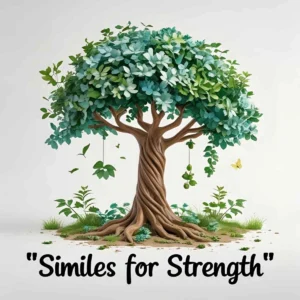The Wild Charm of Similes 🐾
Similes are like pawprints in the sand, leaving vivid trails in language by comparing two unlike things with “like” or “as.” They transform simple descriptions into captivating images, making writing and speech roar with life. Instead of saying, “The lion was strong,” try “The lion roared like a thunderstorm, shaking the savanna.”
Similes add color and relatability, especially when describing animals, from majestic wildlife to cuddly pets. Whether in stories, poems, or casual chats, these comparisons make animals leap off the page. Ready to explore the animal kingdom through words? Let’s dive into 25 similes for animals, sorted by theme, to spark your imagination! 🦁
Similes for Animals: 25 Vivid Comparisons
These 25 similes capture the essence of animals—their strength, grace, quirks, and cultural significance. Organized into thematic groups, each simile includes a meaning, a contextual example, and a specific application for writing, speaking, or storytelling. Let’s roam through this menagerie of metaphors!
Animals in Majestic Motion 🦅
Similes for animals showcasing power, speed, or grace.
- Lions roar like thunderstorms, shaking the earth with might.
Meaning: Lions exude raw power, like storms unleash booming energy.
Example: In a wildlife documentary script, “The lion roared like a thunderstorm, commanding the savanna’s silence.”
Application: Use in adventure stories or a speech about leadership, e.g., “Her presence roared like a thunderstorm in the meeting.” - Cheetahs streak like lightning, flashing across the plains.
Meaning: Cheetahs move with electrifying speed, like lightning bolts.
Example: In a nature poem, “The cheetah streaked like lightning, a blur against the golden grass.”
Application: Perfect for sports blogs or a caption about racing, e.g., “I streaked like a cheetah to finish the race! ⚡” - Eagles soar like kites, riding the winds of freedom.
Meaning: Eagles glide effortlessly, like kites dancing in the sky.
Example: In a travel memoir, “The eagle soared like a kite, tracing circles above the mountain peaks.”
Application: Use in reflective essays or a post about ambition, e.g., “My dreams soar like kites.” - Horses gallop like drumbeats, pounding the earth’s rhythm.
Meaning: Horses move with rhythmic power, like drums in a march.
Example: In a Western novel, “The horse galloped like drumbeats, echoing through the canyon.”
Application: Great for historical fiction or a speech about determination. - Dolphins leap like acrobats, twirling through ocean waves.
Meaning: Dolphins move with playful grace, like acrobats in a show.
Example: In a beach story, “The dolphin leaped like an acrobat, delighting the boaters.”
Application: Use in travel writing or a caption about joy, e.g., “Feeling like a dolphin acrobat today! 🐬”
Animals in Quiet Grace 🌿
Similes for animals in calm, subtle, or stealthy moments.
- Cats slink like shadows, gliding through the night.
Meaning: Cats move silently, like shadows cast by moonlight.
Example: In a mystery novel, “The cat slinked like a shadow, unnoticed by the sleeping house.”
Application: Use in suspense stories or a tweet about stealth, e.g., “Slinking like a cat to avoid chores! 😸” - Deer tiptoe like ballerinas, stepping lightly through the forest.
Meaning: Deer move with delicate grace, like ballerinas on a stage.
Example: In a nature poem, “The deer tiptoed like a ballerina, dancing through the misty woods.”
Application: Perfect for poetic descriptions or a journal entry about tranquility. - Turtles plod like philosophers, pondering each step.
Meaning: Turtles move slowly and thoughtfully, like philosophers lost in thought.
Example: In a children’s story, “The turtle plodded like a philosopher, wise and unhurried.”
Application: Use in reflective writing or a post about patience, e.g., “Moving like a turtle philosopher today.” - Owls glide like whispers, silent in the moonlight.
Meaning: Owls move quietly, like whispers barely heard.
Example: In a spooky tale, “The owl glided like a whisper, unseen above the haunted forest.”
Application: Great for horror stories or a caption about quiet focus. - Butterflies flutter like confetti, scattering color in the breeze.
Meaning: Butterflies dance lightly, like confetti at a celebration.
Example: In a garden blog, “The butterfly fluttered like confetti, brightening the flowerbeds.”
Application: Use in nature writing or a post about beauty, e.g., “Feeling like butterfly confetti! 🦋”
Animals as Emotional Symbols 🐘
Similes for animals evoking feelings or relationships.
- Dogs wag like metronomes, keeping time with joy.
Meaning: Dogs express happiness rhythmically, like metronomes in music.
Example: In a family story, “The dog wagged like a metronome, greeting her with boundless glee.”
Application: Use in heartwarming tales or a caption about pets, e.g., “My pup wags like a metronome! 🐶” - Elephants lumber like grandparents, wise and steady.
Meaning: Elephants move with calm wisdom, like beloved elders.
Example: In a memoir, “The elephant lumbered like a grandparent, guiding the herd with care.”
Application: Perfect for nostalgic essays or a speech about guidance. - Kittens pounce like toddlers, bursting with playful curiosity.
Meaning: Kittens explore with eager energy, like curious children.
Example: In a pet blog, “The kitten pounced like a toddler, chasing the yarn ball.”
Application: Use in parenting stories or a post about playfulness. - Wolves howl like poets, singing to the moon’s heart.
Meaning: Wolves express deep emotion, like poets reciting verse.
Example: In a fantasy novel, “The wolf howled like a poet, serenading the starry night.”
Application: Great for poetic writing or a caption about expression, e.g., “Howling like a wolf poet tonight! 🌙” - Swans glide like lovers, graceful in their dance.
Meaning: Swans move with romantic elegance, like lovers in harmony.
Example: In a romance story, “The swans glided like lovers, mirroring their bond on the lake.”
Application: Use in love poems or a post about connection.
Animals in Playful Chaos 🐒
Similes for animals in energetic, mischievous, or social settings.
- Monkeys chatter like gossipers, buzzing with jungle news.
Meaning: Monkeys talk noisily, like friends sharing rumors.
Example: In a zoo story, “The monkeys chattered like gossipers, swinging through the trees.”
Application: Use in funny dialogues or a caption about lively chats, e.g., “Chattering like monkeys with friends! 🐒” - Squirrels scamper like pranksters, darting from trouble.
Meaning: Squirrels move quickly and mischievously, like playful tricksters.
Example: In a park scene, “The squirrel scampered like a prankster, stealing the picnic nuts.”
Application: Perfect for humor stories or a tweet about mischief. - Puppies tumble like clowns, tripping over their own paws.
Meaning: Puppies move clumsily, like clowns in a circus.
Example: In a pet vlog, “The puppy tumbled like a clown, chasing its tail in circles.”
Application: Use in pet blogs or a post about silly moments. - Parrots squawk like comedians, stealing the spotlight.
Meaning: Parrots make bold noises, like comedians grabbing attention.
Example: In a classroom scene, “The parrot squawked like a comedian, mimicking the teacher.”
Application: Great for funny stories or a caption about standing out. - Otters frolic like partygoers, splashing with glee.
Meaning: Otters play energetically, like guests at a lively party.
Example: In a nature documentary, “The otters frolicked like partygoers, diving in the river.”
Application: Use in adventure writing or a post about fun, e.g., “Frolicking like otters today! 🦦”
Animals in Cultural Tales 🐉
Similes inspired by cultural or mythical animal imagery.
- Dragons blaze like furnaces, breathing ancient fire.
Meaning: Dragons exude mythical power, like furnaces radiating heat.
Example: In a fantasy epic, “The dragon blazed like a furnace, guarding its golden hoard.”
Application: Use in mythical stories or a speech about strength. - Tigers prowl like emperors, ruling the jungle’s heart.
Meaning: Tigers move with regal authority, like emperors in a kingdom.
Example: In a cultural tale, “The tiger prowled like an emperor, commanding the forest’s respect.”
Application: Perfect for cultural writing or a post about confidence. - Tortoises endure like sages, carrying homes of wisdom.
Meaning: Tortoises persist with calm insight, like wise elders.
Example: In a fable, “The tortoise endured like a sage, steady in the race.”
Application: Use in moral tales or a caption about resilience. - Peacocks strut like artists, flaunting colorful creations.
Meaning: Peacocks display beauty boldly, like artists showcasing work.
Example: In a festival scene, “The peacock strutted like an artist, dazzling the crowd.”
Application: Great for cultural blogs or a post about self-expression. - Phoenix rises like a dreamer, reborn from ashes.
Meaning: Phoenixes renew with hope, like dreamers chasing new goals.
Example: In a motivational speech, “She rose like a phoenix, thriving after failure.”
Application: Use in inspirational writing or a post about overcoming setbacks.
Creative Examples to Spark Imagination 🌈
These similes bring animals to life with vivid flair. “Cats slink like shadows” paints a sneaky feline perfect for a mystery, while “monkeys chatter like gossipers” captures a hilarious zoo scene for a vlog. Ever seen a friend “tumble like a puppy clown”? Try it in a group chat! Which simile roars for you—do you soar like an eagle or scamper like a squirrel?
Try This: Pick a simile and write a sentence about an animal you saw today, like “The bird soared like a kite over my backyard.” Share it in a journal or text!
Practical Applications for Every Voice 🖌️
These similes can enliven your work or chats:
- Stories: Use “lions roar like thunderstorms” in an adventure novel to show power, or “puppies tumble like clowns” for a funny pet tale.
- Poems: Add “butterflies flutter like confetti” to a nature poem for vivid imagery.
- Speeches: Say “We rise like phoenixes” in a graduation speech to inspire resilience.
- Social Media: Post “Strutting like a peacock at the party! 🦚” for event vibes.
- Casual Chats: Toss “I’m scampering like a squirrel to finish this!” into a study group text.
Challenge: Rewrite a dull sentence from your day with a simile, like “I ran fast” to “I streaked like a cheetah to class.” Notice the spark it adds!
Conclusion: Let Animals Inspire Your Words 🦄
Similes are your safari guide to making language wild and unforgettable. From “thunderstorm” lions to “confetti” butterflies, these comparisons turn animals into stars of your stories, poems, or chats. So, grab a simile and try it—maybe “I’m soaring like an eagle” in your next essay. Better yet, create your own: are you a “tiger emperor” in a meeting? Share it with a friend or post it online to spread the fun. The animal kingdom is your canvas—paint it with words! 🦒



